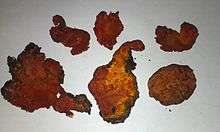Taiwanofungus camphoratus
| Taiwanofungus camphoratus | |
|---|---|
 | |
| Taiwanofungus camphoratus | |
| Scientific classification | |
| Kingdom: | Fungi |
| Division: | Basidiomycota |
| Class: | Agaricomycetes |
| Order: | Polyporales |
| Genus: | Taiwanofungus |
| Species: | T. camphoratus |
| Binomial name | |
| Taiwanofungus camphoratus (M.Zang & C.H.Su) Sheng H.Wu, Z.H.Yu, Y.C.Dai & C.H.Su (as comphoratus) (1994) | |
| Synonyms[2] | |
| |
Taiwanofungus camphoratus, also known as stout camphor fungus (Chinese: 牛樟芝), is a species of fungus that is endemic to Taiwan, where it grows only on the endemic tree Cinnamomum kanehirae, causing a brown heart rot. Synonyms include Antrodia camphorata and Ganoderma camphoratum.
Traditional medicine
The fungus is well-known and highly valued as a medicinal mushroom in Taiwan where it is known as niu-chang, niu-chang-ku, or niu-chang-chih. It is commonly used as an anti-cancer, anti-itching, anti-allergy, anti-fatigue,[3] and liver protective herb in Taiwanese traditional medicine.[4][5] An extract was reported to slow the growth of human breast cancer cells.[6] A water extract of mycelium grown in liquid culture has been reported to have antioxidant and anticancer properties in vitro.[7]
Recently, the 32.15 Mb genome containing 9,254 genes was sequenced.[8]
Chemical constituents
Antcin B, antrodioxolanone, antrocamphin B, antroquinonol, antrocamphins, zhankuic acids, and other antcins have been reported as constituents of Taiwanofungus camphoratus.
Ecological concern
Because of its use as a medicinal mushroom, fruiting bodies of the fungus can fetch high prices. Good quality fruiting bodies were reported to cost as much as US $15,000/kg in 1997, before artificial cultivation methods were developed.[9] Some have illegally farmed the fungus in the forests of Taiwan by hollowing out endangered stout camphor trees (Cinnamomum kanehirae or niu zhang Chinese: 牛樟).[10] This despite the equal potency of T. camphotatus grown indoors.[11]
References
- ↑ "Taiwanofungus camphoratus". IUCN Red List of Threatened Species. 2017. Retrieved 2 October 2017.
This taxon has not yet been assessed for the IUCN Red List, but is in the Catalogue of Life: Taiwanofungus camphoratus (M. Zang & C.H. Su) Sheng H. Wu, Z.H. Yu, Y.C. Dai & C.H. Su, 2004
- ↑ "Taiwanofungus camphoratus". NCBI Taxonomy. Bethesda, MD: National Center for Biotechnology Information. Retrieved 2 October 2017.
Antrodia camphorata synonym: Taiwanofungus comphoratus synonym: Ganoderma comphoratus synonym: Ganoderma camphoratum synonym: Antrodia cinnamomea
- ↑ Patent: Anti-fatigue cyclohexenone compounds from Antrodia camphorata
- ↑ Ao ZH, Xu ZH, Lu ZM, Xu HY, Zhang XM, Dou WF; Xu; Lu; Xu; Zhang; Dou (January 2009). "Niuchangchih (Antrodia camphorata) and its potential in treating liver diseases". J Ethnopharmacol. 121 (2): 194–212. doi:10.1016/j.jep.2008.10.039. PMID 19061947.
- ↑ Liu, YW; Lu, KH; Ho, CT; Sheen, LY (2012). "Protective effects of Antrodia cinnamomea against liver injury". J Tradit Complement Med. 2 (4): 284–294. PMC 3942906. PMID 24716143.
- ↑ Hseu YC, Chen SC, Chen HC, Liao JW, Yang HL; Chen; Chen; Liao; Yang (August 2008). "Antrodia camphorata inhibits proliferation of human breast cancer cells in vitro and in vivo". Food Chem. Toxicol. 46 (8): 2680–8. doi:10.1016/j.fct.2008.04.036. PMID 18550246.
- ↑ Hseu, Y-C; Chang, W-C; Hseu, Y-T; Lee, C-Y; Yech, Y-J; Chen, P-C; Chen, J-Y; Yang, H-L (2002). "Protection of oxidative damage by aqueous extract from Antrodia camphorata mycelia in normal human erythrocytes". Life Sciences. 71 (4): 469–482. doi:10.1016/s0024-3205(02)01686-7.
- ↑ Lu, MY.; Fan, WL.; Wang, WF.; Chen, T.; Tang, YC.; Chu, FH.; Chang, TT.; Wang, SY.; Li, MY.; Chen, Y. H.; Lin, Z. S.; Yang, K. J.; Chen, S. M.; Teng, Y. C.; Lin, Y. L.; Shaw, J. F.; Wang, T. F.; Li, W. H. (Oct 2014). "Genomic and transcriptomic analyses of the medicinal fungus Antrodia cinnamomea for its metabolite biosynthesis and sexual development". Proc Natl Acad Sci U S A. 111 (44): E4743–52. Bibcode:2014PNAS..111E4743L. doi:10.1073/pnas.1417570111. PMC 4226107. PMID 25336756.
- ↑ Wu SH, Ryvarden L, Chang TT (1997). "Antrodia camphorata ("niu-chang-chih"), new combination of a medicinal fungus in Taiwan". Bot Bull Acad Sin. 38: 273–275.
- ↑ China Post news staff (12 March 2012). "Taitung takes action to help prevent loss of Ligavon's last ancient camphor". Taiwan: The China Post. Retrieved 12 March 2012.
Many timber thieves drill away stout camphor trunks, collecting the fungi, selling the timber, and leaving gigantic “tunnels” in the enormous trees' trunks.
- ↑ China Post news staff (2 March 2010). "Cultivated camphor fungi as effective as wild ones". Taiwan: The China Post. Retrieved 12 March 2012.
The medical effect of wild stout camphor fungi (牛樟芝) is the same as cultivated ones, according to a study of the Department of Forestry at National Chung Hing University (NCHU).
External links
- Taiwanofungus camphoratus in Index Fungorum

